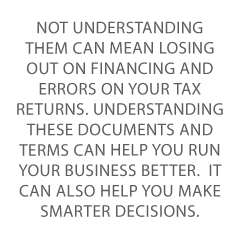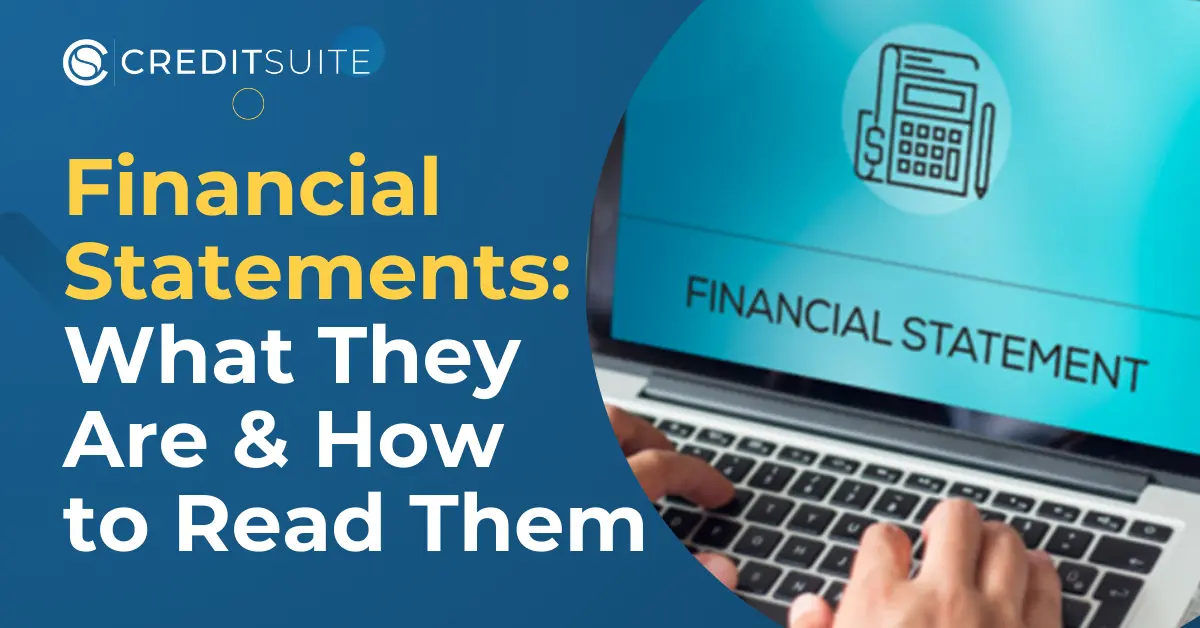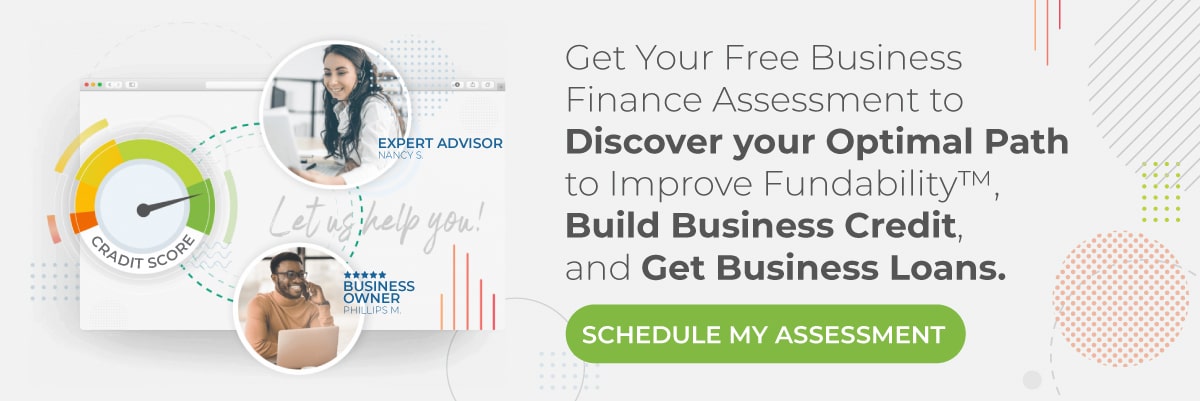Your business finances are a vital part of your operation. Do you know how to read your business financial statements?
Not understanding them can mean losing out on financing and can lead to errors on your tax returns. Understanding these documents and terms can help you run your business better. It can also help you make smarter decisions.
Not only that, but lenders may ask to see business financial statements along with other documents. These include business bank account statements and merchant account statements. They may also ask for personal financial information, tax returns, and more.
Knowing what the numbers on these documents mean is vital. Understanding what lenders are looking for can help you understand funding decisions and make adjustments if necessary.
Don’t be tempted to rely on a CPA or bookkeeper to explain these things to you. As a business owner, it’s vital that you have at least an overall understanding of what your financials are telling you about your business.
Otherwise, you will not be able to tell when there is a problem. No one wants to think someone they trust would try to pull one over one them. Yet, if you understand your own business finances, that’s one less thing you have to worry about.
Business Financial Statements
These will include an Income Statement, a Balance Sheet, and a Statement of Cash Flows. Not surprisingly, credit providers want to see that the business is profitable.
They also want to see what other debt is outstanding, what assets the business owns, and that there is enough cash available to run the company.
Lenders can use these reports to make a number of calculations that will help with the decision making process.
Traditional banks usually have a credit analyst that handles this. Often, an analyst will compare financial statements for at least the past three years.
If they can get more financial history, that is even better. First, they will look for trends and patterns. Then, they will ask for explanations for major changes from one year to the next.
For example, if there is a sudden increase in debts or expenses, or decrease in the bottom line, they will question that.
Audited Financial Statements vs. Company Prepared Financial Statements
This is why audited financial statements provide even stronger Fundability™. These statements will already have notes explaining any major fluctuation. Also, lenders view them as more reliable.
Of course, it also makes it easier on credit analysts to make a recommendation. Not to mention, it makes it possible for underwriters to get their job done faster.
Now, it does cost money to have financials audited. However, you can use the fee as a tax deduction.
Definitions of Important Accounts
The Statement of Income and Expense accounts are pretty straight forward. There are the income sources, and the expenses are deducted from income for a bottom line.
The Balance Sheet accounts may require a little more explanation.
Balance Sheet
“The balance sheet is a financial statement that provides a snapshot of what a company owns and owes, as well as the amount invested by shareholders.
Balance sheets can be used with other important financial statements to conduct fundamental analysis or calculate financial ratios.” -Investopedia
Accounts Payable
“Accounts payable (AP) refers to an account within the general ledger that represents a company’s obligation to pay off a short-term debt to its creditors or suppliers.
Another common usage of “AP” refers to the business department or division that is responsible for making payments owed by the company to suppliers and other creditors.” -Investopedia
AR (Accounts Receivable)
“Accounts receivable (AR) is the balance of money due to a firm for goods or services delivered or used but not yet paid for by customers.
Accounts receivables are listed on the balance sheet as a current asset. AR is any amount of money owed by customers for purchases made on credit.” -Investopedia
Cash Flow
“The term cash flow refers to the net amount of cash and cash equivalents being transferred in and out of a company. Cash received represents inflows, while money spent represents outflows.” -Investopedia
Current Assets
Current assets represent all the assets of a company that are expected to be conveniently sold, consumed, used, or exhausted through standard business operations within one year.
Important Ratios
Lenders also look at certain ratios to help determine creditworthiness. These are some of the ratios lenders use most commonly, and what they learn from them.
Current Ratio
First, the current ratio can help you understand whether a business will be able to meet obligations, even if the unexpected happens. The calculation is total assets divided by total liabilities.
Consider this example. If your business has $30,000 in assets and owes $15,000, the current ratio is 2:1. Assets are double the amount of debt. Obviously, that looks good to lenders.
Quick Ratio
Another useful ratio is the quick ratio. Like the current ratio, it shows assets vs. liability, except it reduces total assets by total inventory.
Since you cannot turn inventory into cash immediately, this gives a more clear picture of liquidity. A business cannot use inventory to pay obligations right away.
If something happens and you need all the cash you can get from your assets immediately, inventory would not be included. A healthy quick ratio is 1 or more.
Receivable Turnover Ratio
“The term receivables turnover ratio refers to an accounting measure that quantifies a company’s effectiveness in collecting its accounts receivable.” -Investopedia
This ratio measures how well a company uses and manages the credit it extends to customers, and how quickly that short-term debt is collected or is paid.
An efficient company has a higher accounts receivable turnover ratio while an inefficient company has a lower ratio.
Many use this metric to compare companies within the same industry to gauge whether they are on par with their competitors.
Debt-to-Worth Ratio
The debt-to-worth ratio is total liabilities divided by net worth. Net worth is calculated as total assets minus total liabilities.
This ratio tells you, and lenders, how much you owe versus how much you own. Put another way, how much of the business is really yours, free of debt.
Your Business Bank Account
For a standard business bank account, you want an account which you can get to easily and will provide you with the functionality that you need. Online services and a phone app are necessities.
Your Basic Business Checking Account
You’re probably not going to get much in terms of interest from any business account. This is much like with your personal accounts.
There are free business checking accounts available. However, many have a minimum deposit or average minimum balance requirement.
Consider how much you may need to keep in a business account in order to get free services. Then weigh the free services against the services you actually need. After that, look for accounts that offer the following.
Low Fees
Find out which fees you may need to pay, and what you need to keep your fees lower. If an account requires a high balance to not have to pay fees, you’re probably better off looking elsewhere.
The benefits of not paying fees may not necessarily offset being unable to quickly access your funds.
Higher Interest
Don’t expect high interest. But if you can get something more than the minimum, then that’s a worthwhile consideration.
However, as with fees, find out what kind of cash you need to keep in your accounts to get the best interest rates.
Your business needs come first, and that means liquidity. There isn’t a lot of benefit to a higher interest rate if you can’t access the money.
FDIC Insured
“The Federal Deposit Insurance Corporation (FDIC) is an independent agency created by the Congress to maintain stability and public confidence in the nation’s financial system. The FDIC insures deposits; examines and supervises financial institutions for safety, soundness, and consumer protection; makes large and complex financial institutions resolvable; and manages receiverships.” -fdic.gov
Ability to Transfer Between Accounts Easily
How much work is it to transfer between your business checking account and any other business bank account?
If you’ve got some cash in a savings account, then you’ll want to be able to tap into it to make credit card payments or cover business expenses.
If you can’t readily move money from account to account for paying bills, then it’s probably not the best business banking account for you.
Why Do Business Bank Accounts Need to Be Separate From Personal Accounts?
There are actually a number of reasons. First, it’s much easier to keep business and personal finances separate. That, in turn, makes filing taxes tremendously easier.
Aside from that, many vendors require a separate business bank account before they will extend credit. This is even true of some starter vendors.
Furthermore, it is not possible to get a merchant account without a business bank account.
Without a merchant account, you cannot accept credit card payments. Generally speaking, people tend to spend more when they can use credit.
As a result, not accepting credit card payments could lose a business a lot of sales.
Other Documents Lenders May Require
In addition to those already listed, there are several other documents a lender may ask for. This is particularly true if you are applying for a loan that is guaranteed by The Small Business Administration.
They are going to require even more documentation. Here are some examples of other documents that may be necessary.
- Personal background and financial statement
- Projected financial statements
- Ownership and affiliations documents
- Business licenses and certifications
- Loan application history
- Personal and business tax returns
- Business overview and history
- Any business leases
Of course, this is not a complete list, but you get the idea.
Financial Statements Are an Essential Part of Funding a Business
In the end, lenders just want to see that a business is credit worthy. They do that by looking at a number of different things, including financial statements.
That’s not always just the Income Statement and Balance Sheet however.
It can also include business bank account and merchant accounts statements. This is only one reason why separate business banking is necessary.
If you have a business savings account, they’ll want to see that too. All business bank statements will be important.
They’ll likely also check your business credit report as well as your personal credit. They will want to make sure your basic information matches up on all documents and statements.
Even something as small as an ampersand in one place and the word “and” in another can complicate things and make it harder to get funding.
So, it’s not just about making payments on time. You also need to have these financials and documents prepared and ready.
That means for all accounts. Most any lender at a traditional bank is going to ask businesses for these. Printing them off of your accounting software isn’t the worst thing you can do. Still, having a professional prepare them is better. Audited financial statements are best.
As for statements, it really isn’t necessary any longer to keep paper copies forever. But, be sure you know how to access these statements when you need them. The faster you can provide underwriters what they need, the smoother and faster the process will be.
What Else Is Necessary to Get Business Funding?
Financial Statements and documents are necessary. However, if your business isn’t set up to be Fundable, you are still likely to run into trouble. This is where a Fundable Foundation comes in. Not only can Credit Suite help you make sure your business is as Fundable as possible, but we can help you find the perfect financing for your business now, while helping you build Fundability™, including business credit, so you can access more funding with better terms in the future.


